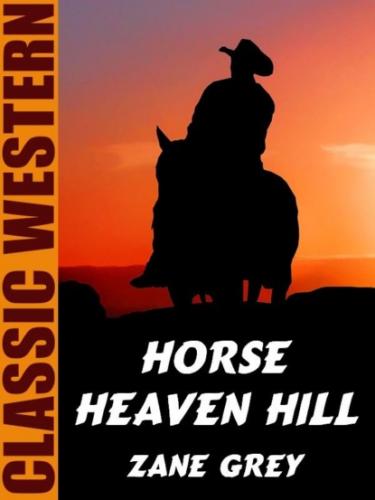Horse Heaven Hill. Zane Grey
ection>
Table of Contents
HORSE HEAVEN HILL
ZANE GREY
Introduction by Karl Wurf.
COPYRIGHT INFORMATION
Copyright © 2020 by Wildside Press LLC.
Introduction copyright © 2020 by Karl Wurf.
Text copyright © 1959 by Zane Grey, Inc.
Published by Wildside Press LLC.
wildsidepress.com | bcmystery.com
INTRODUCTION
Pearl Zane Grey (1872-1939) was an American author (and dentist!) best known for his popular adventure novels and stories associated with the western genre; he idealized the American frontier. Riders of the Purple Sage (1912) was his best-selling book.
Grey was born in Zanesville, Ohio, on January 31, 1872. His parents were Lewis Grey and Alice Josephine Zane Grey. He was an excellent baseball player in school and won a baseball scholarship to the University of Pennsylvania, where he studied to become a dentist. After graduating, Grey established his practice in New York City under the name of Dr. Zane Grey in 1896. It was a competitive area but he wanted to be close to publishers to pursue his dream of being a writer. He began to write in the evening to offset the tedium of his dental practice.
His first novel, Betty Zane, was inspired by stories he heard about the Ohio frontier as a child. Unfortunately, he was unable to sell it at the time and self-published it. He began to study his craft and travel to the west, taking notes and copying down dialog he heard. He studied other successful novels, such as Owen Wister’s The Virginian, and continued to polish his craft. His next three novels were all rejected by publishers, though. Instead of giving up, though, he perseviered.
Grey married longtime girlfriend Lina Elise “Dolly” Roth in 1905 after a passionate and intense courtship marked by frequent quarrels. After they married, Dolly gave up her teaching career. They moved to a farmhouse at the confluence of the Lackawaxen and Delaware rivers, in Lackawaxen, Pennsylvania, where Grey's mother and sister joined them. (This house, now preserved and operated as the Zane Grey Museum, is listed on the National Register of Historic Places.) Grey finally ceased his dental practice to work full-time on his nascent literary pursuits. Dolly's inheritance provided an initial financial cushion.
Finally Grey got his first break, selling The Heritage of the Desert in 1910 to Harper's Magazine. It became a best-seller. Two years later, Harper’s also published Riders of the Purple Sage—and his career was properly launched. Zane Grey was officially more than a one-book wonder.
After publication of The Heritage of the Desert, the family had moved west to Altadena, California. Grey also aquired a hunting lodge in Arizona. Each year, Grey spent time traveling in the west and fishing in the Pacific. He then would return home and spend time writing.
While Dolly managed Grey's career and raised their three children (Romer, Betty, and Loren), over the next two decades Grey often spent months away from the family. He fished, wrote, and spent time with his many mistresses. While Dolly knew of this behavior, she seemed to view it as his handicap rather than a choice. Throughout their life together, he highly valued her management of his career and their family, and her solid emotional support. In addition to her considerable editorial skills, she had good business sense and handled all his contract negotiations with publishers, agents, and movie studios. All his income was split fifty-fifty with her; from her “share” she covered all family expenses. Their considerable correspondence shows evidence of his lasting love for her despite his infidelities and personal emotional turmoil.
Grey died unexpectedly of a heart attack on October 23, 1939. By the time of his death, he had authored almost ninety books. The majority were westerns, but he also wrote nine books that had a fishing theme; several about baseball; a biography of George Washington as a young man; many short stories; and several stories for children.
—Karl Wurf
Rockville, Maryland
CHAPTER ONE
That northern section of the state of Washington, as far as the ranch land was concerned, encroached upon wild country, the margin of civilization, the rolling sage plains, blue as the sky, which terminated in a mountain called Horse Heaven Hill.
Viewed from the Wade ranch house, from a knoll overlooking the thriving town, the open country spread like a fan to the north and west. The gray expanse merged in the blue, without any barren patches, and spread away, soon to heave into mounds and hills, timber-topped and shaggy, which waved onto the range of mountains. Out beyond somewhere rolled the great Oregon, mighty river of the Northwest. The scene had all the austere beauty characteristic of this north country when uncultivated. South of the little city the sage had given way to wheat. Here Wadestown was the most northerly outpost, located on the railroad that ran almost east and west, and which served as the border line of the wilderness.
Far out on the sunny reaches tiny black dots and clouds of dust furnished telltale signs of riders. They might have been driving cattle, but considering the absence of any cattle in the wide foreground this was doubtful to experienced eyes. Moreover, it was wild-horse country.
Horse Heaven Hill towered on the Clespelem Indian Reservation. The wild mustangs were wilder than deer and they were the
